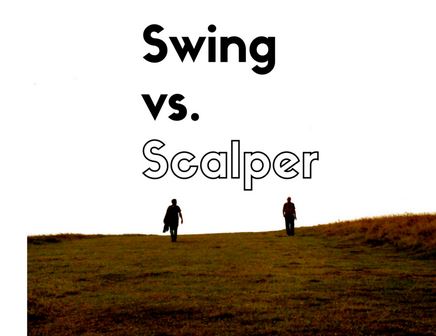There are numerous distinctions between swing trading and scalping. Time, profit, risk, and financial management are just a few variables that can vary.
Scalping is a high-risk trading strategy that is not appropriate for novice traders. Conversely, swing trading is beneficial for both novice and seasoned traders.

What exactly is “swing trading”?
Swing trading requires patience to maintain positions for multiple days. Those who don’t have time to monitor charts constantly will benefit from this mode of trading.
Nevertheless, the swing traders should study the market every day. This kind of trading is ideal for those with regular jobs or businesses.
What is meant by scalping?
When you “scalp,” you make many trades quickly. Scalpers monitor the markets for price gaps and other opportunities to profit quickly.
Scalping is a powerful trading strategy in which a trader makes several quick trades to maximize tiny gains. Thus, scalping is often used due to its simplicity and calming effect. A scalper’s strategy prioritizes speed above long-term profitability.
3 major differences between swing trading and scalping
1. The time frames of swing trading and scalping
Tick charts and 1-5 minute charts are popular among traders. Conversely, swing traders focus on shorter time frames, such as daily or weekly charts.
Typically, the same candlestick pattern can be seen in the forex market across all time frames. A scalper is a trader whose goal is to benefit from the rapid ups and downs of the market.
Scalpers can profit from daily candle movements of 100 pips or less. A scalper can make money by focusing on daily charts’ short ups and downs. Conversely, swing traders hold onto their positions regardless of short-term market fluctuations.

2. Duration of a given trade
When you “scalp” the market, you enter and exit positions swiftly. This style of trading requires undivided attention from the dealer. Scalpers have always sought out fast financial gains. They can make 100 pips in one minute if the market cooperates.
Swing traders have to wait several days or weeks to make a profit. If the pattern continues, they might make a nice profit soon. However, if the market is volatile, they should hold off until it stabilizes.
Conversely, swing traders need a firm grasp of technical and fundamental analysis. It’s easier than scalping but still requires much knowledge and practice. The low-stakes environment of swing trading makes it ideal for novice traders.
3. Number of trades
Intraday scalpers keep their positions open for a few minutes at most, never an entire trading day. Professional “scalpers” can make hundreds of transactions in a single day.
In contrast, swing dealers limit themselves to a narrow clientele. Swing traders typically maintain positions for several days, weeks, or even months. Thus, swing traders can focus on time rather than the volume of trades.
Bottom line
There are major advantages and disadvantages to using any trading strategy. Each trading strategy can only guarantee consistent profits over time.
Forex traders who want to succeed should craft an individual trading strategy considering their knowledge, temperament, available time, and account balance.


